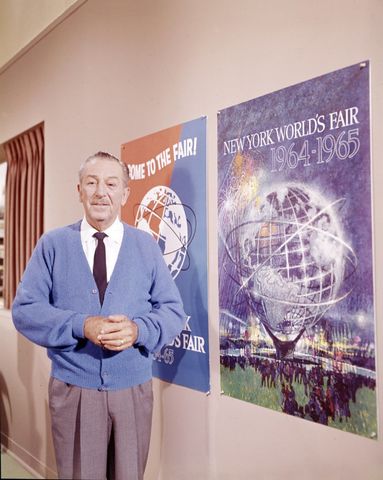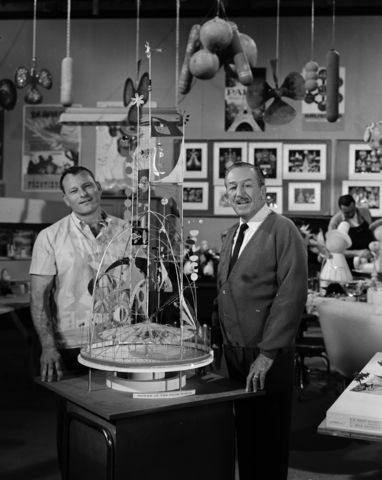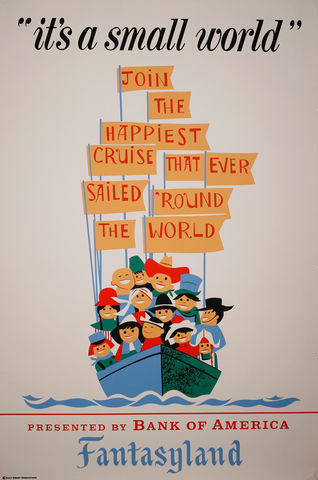This year celebrates the 60th anniversary of the 1964/1965 New York World’s Fair, a historic turning point in the career of Walt Disney, the trajectory of The Walt Disney Company, and the spirit of global cooperation. Although “it’s a small world” is one of the most timeless and enduring of all Disney’s creations for the Fair, it was actually the last of the four iconic pavilions created by WED Enterprises (now Walt Disney Imagineering).

“it’s a small world” was constructed with only a year to go until the Fair opened, with United Nations Children’s Fund (UNICEF) and the Pepsi-Cola Company providing the impetus and funding for the pavilion.
“Today a world’s fair seems like a dinosaur from another era, but in the early part of the 20th century they were the place for cultural exchanges and exhibitions of new technology and design,” explains Disney Legend Don Hahn in his book Yesterday’s Tomorrow: Disney’s Magical Mid-Century. The 1964-1965 New York World’s Fair was no different, and remains famous for exhibiting everything from NASA rocket engines; Michelangelo’s sculpture, the Pietà; and a model of the forthcoming World Trade Center. It also helped introduce new technologies like the color television, picture phones, and of course, Disney’s Audio-Animatronics® technology.
Walt was originally hesitant to accept the additional undertaking for UNICEF and Pepsi, but he quickly devised the idea for a “little boat ride,” as one Imagineer put it, to satisfy the needs of the pavilion. “Imagineers thought they already had more than they could handle with the amount of innovation and quality that Disney required,” wrote Hahn. Despite the three other technologically complex pavilions – State of Illinois’ Great Moments with Mr. Lincoln, Ford’s Magic Skyway, and General Electric’s Progressland, featuring the Carousel of Progress – “it’s a small world” quickly demanded the attention of lead Imagineers and Disney Legends such as Rolly Crump and Mary Blair, each of whom exhibited some of their best work for the attraction.

A Beautiful Collage
Originally a Disney animator, Rolly Crump was hand-selected by Walt to make the transition to WED Enterprises in 1959 and became a key designer on projects for Disneyland. After working on projects like Walt Disney’s Enchanted Tiki Room, Crump joined fellow Imagineers Mary Blair and Alice Davis to work on “it’s a small world”— Crump and Davis would later join Blair, earning Disney Legend distinctions in 2004. His hobby of making small propellers and pinwheels to display in his office no doubt inspired one of his most distinct projects: the more-than-100-foot Tower of the Four Winds marquee that was installed outside the entrance to the “it’s a small world” pavilion at the Fair.
Known for her unique color styling, Mary Blair was chosen by Walt to bring “it’s a small world” to life within the required year after initial concepts weren’t to his liking. Her “sense of simplicity and love of folk art influenced the look of the ride,” as Hahn noted, and her artistry was able to speak to each region or country represented in the attraction. In The Art and Flair of Mary Blair: An Appreciation, animator and author John Canemaker explains that “her assemblages [for the ride and its toys] used wallpaper cuttings, cellophane (for a transparent effect) and acrylics, ingeniously combined in interlocked geometric and organic shapes.” Blair and the design team even tried to find authentic fabrics and materials from regions to contribute to being as accurate as possible.
Blair’s work garnered the immense respect and trust of many at WED Enterprises and solidified her place as a Disney Legend. “When she did ‘small world’, [Blair] got into a mode that was above and beyond anything she had ever done before,” Rolly Crump would tell The “E” Ticket magazine. “She [always] had a flair for stylization, but it never reached the pinnacle that it did for ‘small world’. Not only that, but it was a collage. If you look at some of the original artwork, there’s wallpaper glued on it, there’s burlap and doilies. She got childlike when she did this.”
Disney Legend and Imagineer Joyce Carlson—who assisted Crump with realizing Blair’s designs in full dimension— recalled to historian Jim Korkis how “Walt used to come in with Rolly early in the morning and we’d have the coffee wagon back there and he’d have a cup of coffee and go sit on Rolly’s desk. He’d come sit with Rolly and talk about the toys [for “it’s a small world”]…. Then all the big boys would come in and snatch him away.”
While the Imagineers continued developing the attraction’s visual design, Walt tapped brothers Robert and Richard Sherman—future Disney Legends, soon to be known for their musical genius featured in Mary Poppins (1964)—to write the song for the attraction. Walt wanted it to “talk about unity and understanding and brotherly love [without getting] preachy,” as he would say. The Sherman brothers focused on using the commonalities between cultures during a period of global uncertainty to write the lyrics while keeping the song’s tone clear and childlike. As Walt Disney Family Museum blog contributor Sophie Jo would explain, “The simplicity of the song does not detract from its message.” Guests cannot walk through a Disney park without hearing the catchy tune of “it’s a small world”, a refrain now famous for its underlying message of peace

A Joyful Legacy After All
Walt once reflected that “Disneyland is a place of fantasy and adventure. It is built around a carousel,” while “the fair is built around the Science Pavilion.” “it’s a small world” is a true intersection of the World’s Fair’s innovation and futurism and Disneyland’s sense of adventure and storytelling.
As Sophie Jo would explain, the success of the attraction’s flume system to transport guests “caused Walt to reassess his original idea for the mode of guest conveyance on his new Pirates of the Caribbean attraction”. As the popularity of the parks grew, the high-capacity flume system and large-scale use of Audio-Animatronics® figures influenced much of the park experience beyond Pirates of the Caribbean, including the Haunted Mansion and many others as Disney parks expanded their footprint.
Regarded as a pioneer of innovation and culture himself, “the Fair symbolized the pinnacle of Walt’s shared values of futurism and global cooperation,” as The Walt Disney Family Museum’s Marketing and Editorial Specialist Chris Mullen noted. An extension of Walt’s own imagination, “it’s a small world” exhibited the ongoing efforts to foster inclusivity and multicultural perspectives and continues to be a lasting testament to Walt’s hopes for the world through his parks and stories.
“it’s a small world” was also a testament to Walt’s trust in his people. “Walt was really good [on “it’s a small world”],” Rolly Crump said of him. “He never changed any color. He would make some real small statements. He was very excited about the explosion that was taking place [in] this ride. I walked him through… and it was really amazing because he was like a little kid…. The workmen were coming out of the woodworks wanting him to sign [things]. Guys were handing him their driver’s license, anything for him to sign…. I finally said, ‘Do you want me to get these guys out of here?’ He said, ‘No, I’ll sign.’ He was open to that.”
As the Disney parks became a global enterprise themselves, “it’s a small world” would be there too, from Tokyo to Paris to Hong Kong. Today, the Sherman brothers’ famous tune is always playing somewhere around the world, bringing joy to those on the happiest cruise that ever sailed. “I’ve talked to a lot of people,” said Crump. “I’ll meet them and explain that I worked for Disney and that I worked on ‘small world.’ They’ll often say, ‘Oh that’s my favorite ride.’ To be honest with you, I think if you took a [survey], you might get ‘small world’ as one of the top ones…. You know why? It’s happy. It’s cheerful. This may sound kind of corny, but I used to sit outside of ‘small world’ when we first put it in at Disneyland, and I’d sit there and cry watching people come out, because they were laughing and smiling.”
–Maeve Reilly and Lucas Seastrom
Maeve Reilly is a contributing writer for The Walt Disney Family Museum. She’s a Disney pin collector, lover of vintage roadside attractions, and country line dancer.
Lucas O. Seastrom is a writer, filmmaker, and contracting historian for The Walt Disney Family Museum.
Image sources (in order of appearance):
-
Rolly Crump and Walt Disney in front of a model of The Tower of the Four Winds for the 1964-1965 New York World’s Fair; courtesy of the Walt Disney Archives; © Disney
-
Walt Disney in front of print media for the 1964-1965 New York World’s Fair; courtesy of the Walt Disney Archives; © Disney
-
“it’s a small world” Disneyland attraction poster, 1966; collection of the Walt Disney Family Foundation, gift of Ron and Diane Miller; © Disney
